On April 10, 2010, the Tu-154 Polish presidential plane of Lech Kaczynski crashed at an airfield near Smolensk. There were 96 people on board the aircraft – 88 passengers and eight crew members — who were travelling to a mourning ceremony in Katyn. All people aboard were killed, including the Polish president, his wife Maria and many of the country’s high-profile officials.
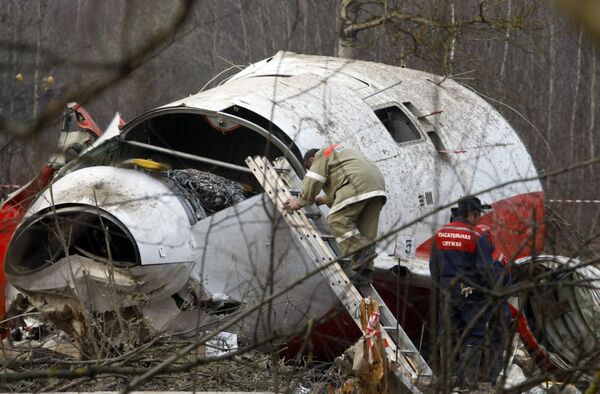
1/12
© AP Photo / Mikhail Metzel
According to a report issued by the Interstate Aviation Committee, the direct cause of the crash was the crew’s decision not to land at an alternative airfield. The crash was also provoked by systematic factors, including insufficient flight support and inadequate crew training.
Above: In this file photo dated Tuesday, April 13, 2010, shows unidentified Emergency ministry workers as they search through the wreckage of the Polish presidential plane of Lech Kaczynski near Smolensk, Russia.
Above: In this file photo dated Tuesday, April 13, 2010, shows unidentified Emergency ministry workers as they search through the wreckage of the Polish presidential plane of Lech Kaczynski near Smolensk, Russia.
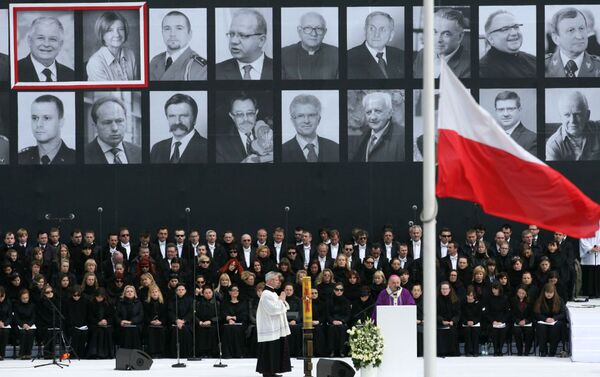
On April 17, 2010, Archbishop Jozef Kowalczyk (above C, R) conducted a mass during for the 96 victims of the presidential plane’s crash.
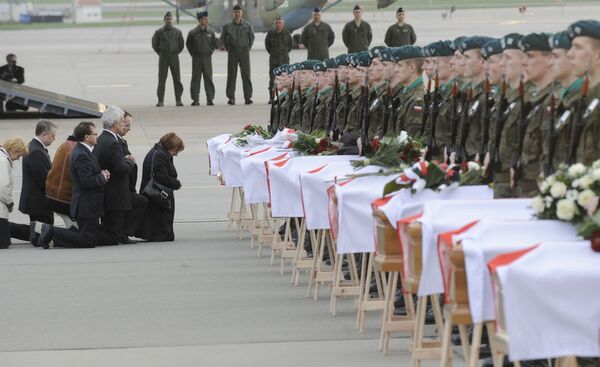
3/12
© AP Photo / Alik Keplicz
Case materials show that General Andrzej Blasik, Commander of the Polish Air Force, was in the cockpit as the plane approached the airport. Experts concluded that Blasik influenced the pilots' decision to land in Smolensk despite air traffic controller warnings.
Above: Relatives of the plane crash victims kneel in front of one of the coffins during a ceremony as 34 coffins arrive from Smolensk at the military airport in Warsaw, Poland.
Above: Relatives of the plane crash victims kneel in front of one of the coffins during a ceremony as 34 coffins arrive from Smolensk at the military airport in Warsaw, Poland.
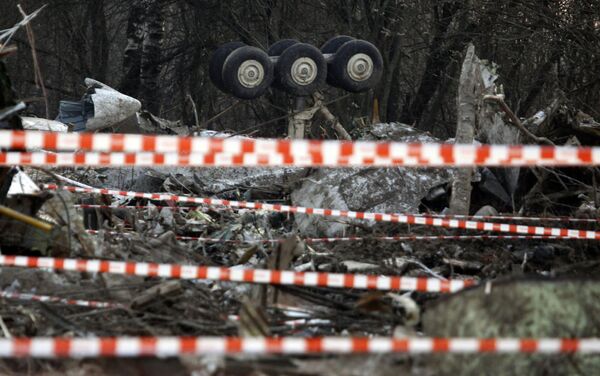
4/12
© AP Photo / Sergey Ponomarev
On July 29, 2011, the Polish government commission into the crash submitted its own report naming the pilot's tardy decision to execute a go-around as the main reason for the crash. The terrain awareness and warning system (TAWS) was not correctly calibrated before the flight, and the crew made mistakes during the landing approach. The pilots ignored TAWS warnings and descended 60 meters below the landing minimum.
Above: Part of a landing gear is seen in the wreckage of the Polish presidential plane which crashed near Smolensk, Russia.
Above: Part of a landing gear is seen in the wreckage of the Polish presidential plane which crashed near Smolensk, Russia.
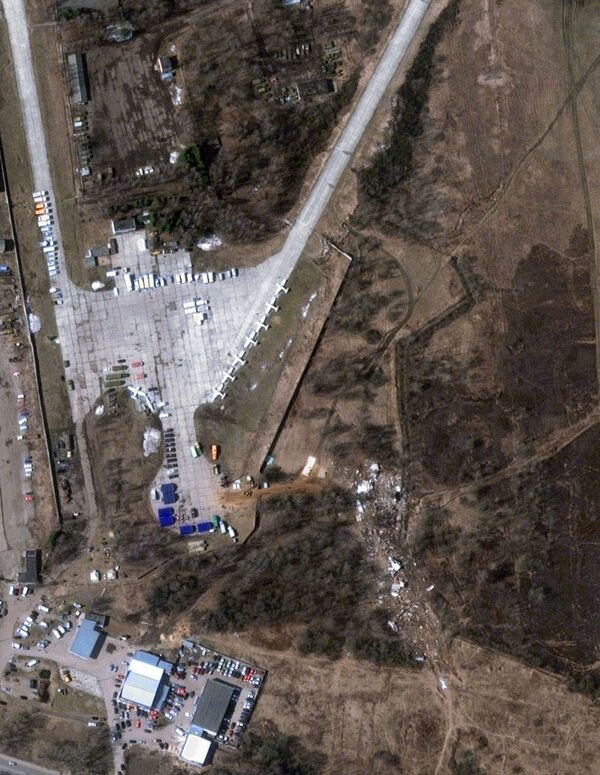
5/12
© AP Photo / DigitalGlobe
According to the government commission’s report, Crew members did not previously completed a sufficiently long simulator training course for bad weather conditions. The commission report claims that the pilots were not pressured.
Above: This satellite image provided by DigitalGlobe shows the site (lower right) of the Tu-154 Polish presidential plane crash outside of Smolensk, Russia.
Above: This satellite image provided by DigitalGlobe shows the site (lower right) of the Tu-154 Polish presidential plane crash outside of Smolensk, Russia.
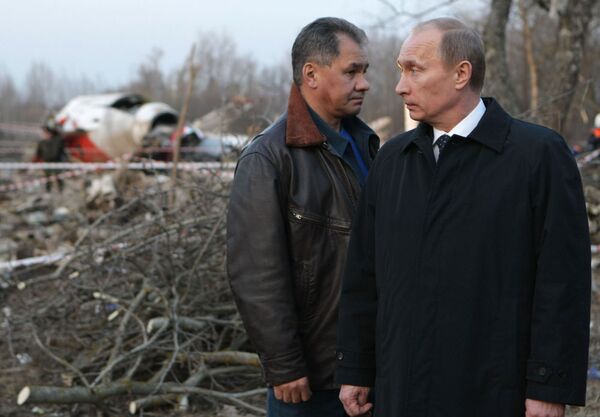
6/12
© Sputnik / Aleksey Nikolskyi
On April 10, 2010, by order of Russian president, Minister of Emergency Situations Sergei Shoigu (L), Transport Minister Igor Levitin, Head of the Investigative Committee Alexander Bastrykin arrived at the crash site. On the evening of April 10, Valdimir Putin (R), who was then-Prime Minister of Russia, and his Polish counterpart Donald Tusk arrived at the site.
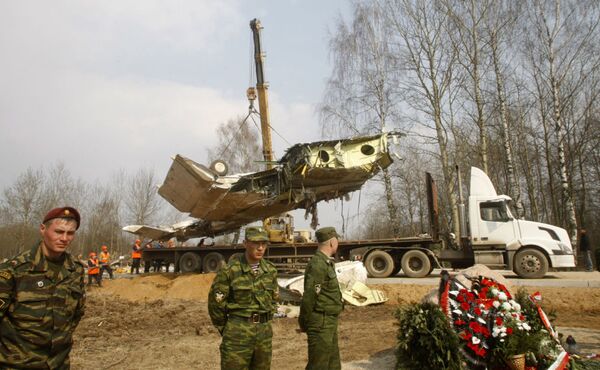
7/12
© AP Photo / Mikhail Metzel
On April 10 at 10:54 p.m. (Moscow Time) the first helicopter of the Russian Emergency Ministry carrying bodies of crash victims landed at the Domodedovo airport in Moscow. In the morning on April 11, families of the victims began arriving in Moscow for identifying bodies.
Above: Police and interior ministry troops secure the scene as emergency ministry workers load the wreckage of the Polish presidential plane on transporter just outside the Smolensk airport.
Above: Police and interior ministry troops secure the scene as emergency ministry workers load the wreckage of the Polish presidential plane on transporter just outside the Smolensk airport.

8/12
© AP Photo / Bela Szandelszky
Bodies of 24 passengers were nominally identified by the documents which were found on them.
Above: Polish people pray on the street while waiting for the arrival of the coffins of late Polish President Lech Kaczynski and his wife Maria Kaczynska in downtown Krakow, Poland, Sunday, April 18, 2010.
Above: Polish people pray on the street while waiting for the arrival of the coffins of late Polish President Lech Kaczynski and his wife Maria Kaczynska in downtown Krakow, Poland, Sunday, April 18, 2010.
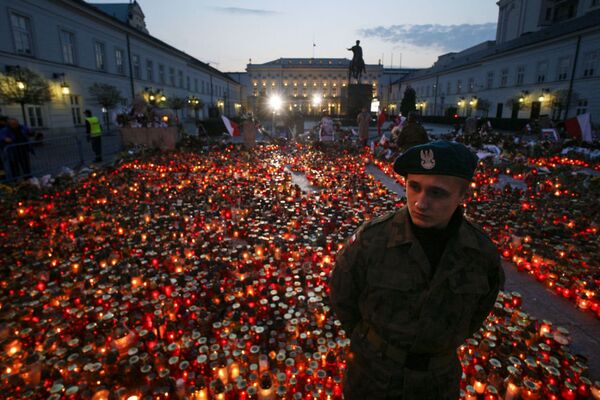
9/12
© AP Photo / Markus Schreiber
After the crash, a seven-day nationwide mourning (to April 16) was declared in Poland. It was extended to April 18 when the funeral of President Kaczynski and his wife Maria was scheduled in the Wawel Castle in Warsaw.
Above: This April 12, 2010, photo shows a soldier standing guard near a sea of candles in front of the President Palace two days after Polish President Lech Kaczynski died in a plane crash.
Above: This April 12, 2010, photo shows a soldier standing guard near a sea of candles in front of the President Palace two days after Polish President Lech Kaczynski died in a plane crash.
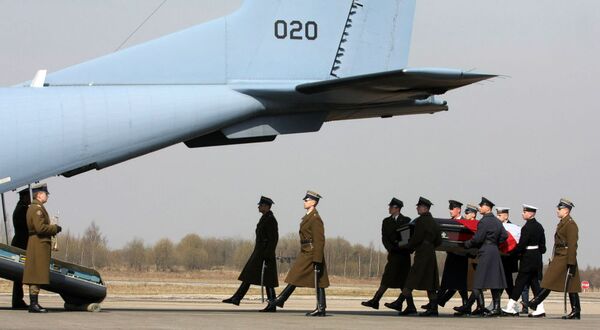
In November 2010 a memorial to those killed in the crash was officially revealed in Warsaw. It looks like a white stone block split in two. There are the signature "In memory of the 96 victims of the plane crash near Smolensk April 10, 2010" and the names of the victims on the monument.
Above: Polish soldiers carry the coffin of Polish President Lech Kaczynski during a farewell ceremony at the airport of Smolensk on April 11, 2010.
Above: Polish soldiers carry the coffin of Polish President Lech Kaczynski during a farewell ceremony at the airport of Smolensk on April 11, 2010.
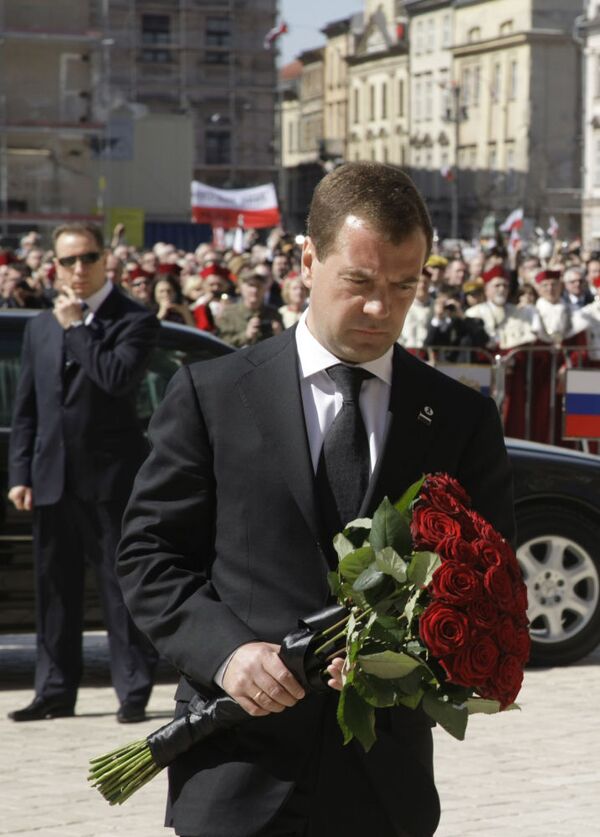
11/12
© Sputnik / Vladimir Rodionov
On April 11, 2010, the body of Lech Kaczynski was transported from Smolensk directly to Warsaw. Before the take-off, a mourning ceremony was held at the airfield. On April 17, a funeral ceremony for the victims of the crash was held in Warsaw. On April 18, Lech Kaczynski and his wife Maria were buried in Krakow.
Above: Dmitry Medvedev, then-President of Russia, lays flowers during the funeral ceremony for Polish President Lech Kaczynski.
Above: Dmitry Medvedev, then-President of Russia, lays flowers during the funeral ceremony for Polish President Lech Kaczynski.

On April 24, 2010, it was reported that the remains of all the victims of the crash were transported to Warsaw.
Above: Two Russian policemen look at a helicopter carrying dead bodies from the Polish presidential Tu-154 aircraft crash site near the Smolensk airport on April 10, 2010.
Above: Two Russian policemen look at a helicopter carrying dead bodies from the Polish presidential Tu-154 aircraft crash site near the Smolensk airport on April 10, 2010.

